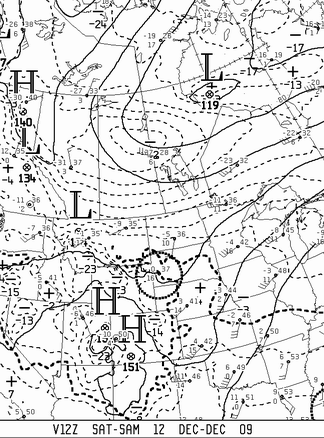

Instructor: Dr. J.D. Wilson
Office: CCIS Room 3-277
Phone: 780 492 0353
E-mail: jaydee.uu@ualberta.ca
Instructor's Office Hours: Mon, Wed, Fri 11-12 (appointment preferred)
Lecture Room & Time: ESB 1-39, Tues & Thurs, 9:30-10:50
Comment: This "practicum"-type course will place a strong emphasis on interpretation of weather analyses and forecasts supplied by Numerical Weather Prediction (NWP), to assist students to understand and use NWP products. Many other types of information complement the information available from weather models, e.g. atmospheric soundings, satellite and radar images, METARs, etc. A theory side of the course will be motivated towards ensuring students are fluent with the vocabulary, symbols and concepts that are relevant to informed discussion of weather situations and forecasts, e.g. the governing equations in vector notation or component form, the role of unresolved scales of motion, idealized models of synoptic weather evolution (the geostrophic and quasi-geostrophic paradigms).
Resources: The course web page (http://courses.eas.ualberta.ca/eas372/) will give course information (dates of assignments and exams; grading criteria) and archive materials used in class.
Class Format: Classes will take place in ESB 1-39, where students will have individual web access. Some exercises and assignments may involve computing and/or graphing. Students may, if they prefer, use their own computers and software; MATLAB is available on computers in ESB 1-39, along with other software (Excel, etc).
Evaluation:
Missed Work:
A student who cannot write the midterm examination or complete an assignment due to illness or other compelling reasons can request that credit for the missed work/exam be transferred to the final exam.
A student who cannot write the final examination due to illness or other compelling reasons can apply for a deferred final examination (please open University Calendar in a new tab). Students who failed at the start of term to request exam accommodations for religious beliefs are expected to follow the normal deferred final examination process. Such an application must be made to the student's Faculty office within two working days of the missed examination and must be supported by a Statutory Declaration or other appropriate documentation (Calendar section 23.5.6). Deferred examinations are a privilege and not a right; there is no guarantee that a deferred examination will be granted.
A deferred exam, if granted, would be held at 1400 on Friday 19 May, 2017.
Disclaimer: Any typographical errors in this Course Outline are subject to change and will be announced in class. The date of the final examination is set by the Registrar and takes precedence over the final examination date reported in this syllabus.
Link to Earth & Atmospheric Sciences home page.